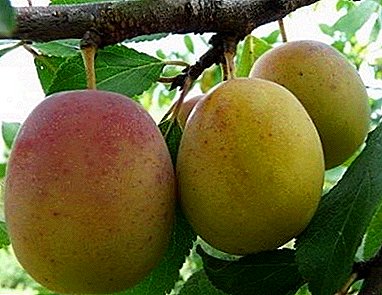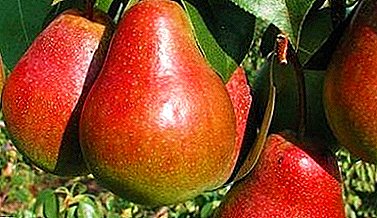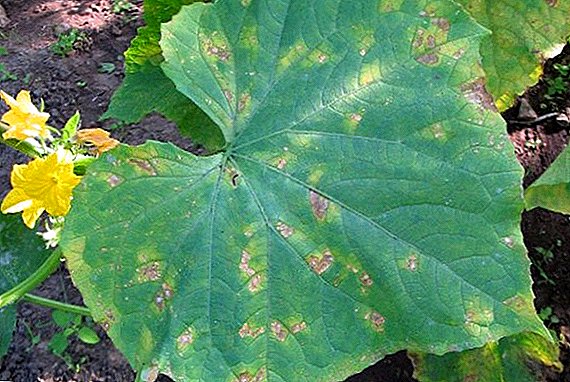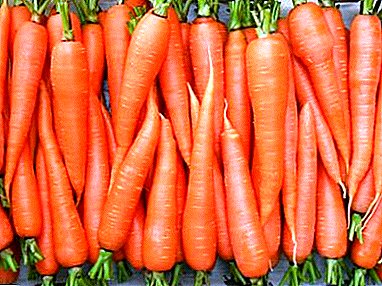 To make poultry farming more profitable and less costly will help a unique breed of chickens - super hard.
To make poultry farming more profitable and less costly will help a unique breed of chickens - super hard.
These highly productive layers will be the optimal solution for large farms and private poultry houses. What special chickens super hard, let's consider.
Breed breeding
Chickens super harko are the pride of breeders from Hungary, by whose efforts the breed was bred. The main role in the process of bird breeding was played by representatives of the Hungarian corporation. Babolna TETRA Kft.that were able to get a highly productive hybrid, effectively working in two directions: egg and meat. The local Hungarian laying hens and the best representatives of the tetra meat birds were involved in the selection process. As a result, the world saw a new breed of meat and egg direction, which combined the best characteristics of its ancestors. 
Description and Features
The anatomical features of the body structure of chickens super harko, as well as their black color are almost identical to the external data of their relatives - chickens harko. However, the former have a heavier weight, due to which they are often confused with traditional broilers.
Crosses broken Brown, Master Gray, Hisex, Hubbard, Redbro, Hungarian Giant, Hercules are also characterized by high meat and egg productivity.
Appearance and physique
As for the appearance of the hens of this breed, they do not have any outstanding, unique qualities. Super hard have a massive, oblong rectangular body with relief, powerful muscles, round thighs, proudly protruding chest, rounded abdomen and medium-sized wings, tight to the body. The head of a bird is of medium size, it has a small, slightly rounded beak of gray color, small gray ear lobes, pink round earrings. On the head there is a comb of a pink shade in the form of a leaf. The tail is beautiful, thick, upright. Cocks from the tail grow large long braids.
The bird is distinguished by strong, strong limbs with yellow-gray or gray plumage, widely spaced from each other. The color of chickens is black, with a greenish tint. In the area of the chest, neck and mane there are golden blotches.
The average weight of a rooster is 4.5 kg, chicken - 3.8 kg. 
Character
By nature, the hybrid super hard is almost perfect. Chickens combined all the best properties of its "genetic basis":
- stress resistance - chickens do not react with a decrease in weight or productivity to stressful situations, for example, temperature drops, housing conditions, etc .;
- peaceful, friendly disposition - the birds never show aggression towards either a person or their relatives, they do not fight and disassemble;
- adaptation to conditions - Super Harco perfectly adapt to different habitat conditions, easily survive the content in the cage.
Hatching instinct
Super hard hawks possess well developed instinct hen. They are able to hatch their offspring on their own, and then raise it. Birds reach sexual maturity at the age of 4-4.5 months. On 20-21 days of incubation, chickens hatching, weighing no more than 40 g. The percentage of young stock is very high and is 95%. Chicks are covered with black gun with small white splashes. Since their adult feathers appear relatively late, they have to warm under the lamp for much longer than common breed chickens. 
Performance Indicators
Representatives of the breed Super Harco are distinguished by rapid growth, high rates of productivity in the first year of life and excellent taste of meat.
Growth and weight gain
Juveniles develop dynamically and are distinguished by good weight. Already in two months, males gain about 2 kg of weight, and chickens - 1.7 kg. These figures increase almost one and a half times after another two months, by the laying period.
Find out when the period of egg production in pullet chickens of different breeds comes, as well as what to do in situations when: chickens do not carry well or carry small eggs, pecking eggs.
After how many begin to sweep and what is egg production per year
Super Harco - early breed of chickens, laying which begins at the age of 21-22 weeks. The weight of one egg on average reaches 60-65 g. The period of intensive egg-laying in a bird lasts about one year, during which it is able to carry 230-240 eggs. Eggs are medium in size, distinguished by a durable brown shell.
After a year of life, egg production begins to decline. And after 2-2.5 years, the bird ceases to bring eggs. That is why it is recommended to send chickens for slaughter after the first year of egg production.
Important! The quality of eggs, as well as their number, is directly dependent on the conditions of the poultry and the nutritional value of the food. The higher these figures, the higher the productivity.
During the period of seasonal autumn molt, egg laying stops for approximately 1.5-2 months. During this period, poultry farmers advise to add to the poultry diet an increased amount of nutrients that will help to quickly resume laying. 
What to feed
To grow a hybrid super hard is easy. One of the main rules is to organize a balanced, proper and complete nutrition.
Did you know? Chickens are very smart birds. They can solve complex problems, transfer knowledge and even worry about their future.
Chickens
Chickens at the beginning of their development are in need of good nutrition, which should be based on boiled eggs. They are mixed with well chopped greens, crushed cereals. The daily menu is also recommended to include low-fat cottage cheese, which is rich in calcium and protein, necessary for the formation of bones and skeleton of chicken.
Up to ten days of age, food is given in a warm, liquid form. We must not forget about clean, fresh water, which should always be with chicks. In addition to water, you can give the young glucose, weak infusion of chamomile, weakly brewed tea.  During intensive growth of chicks, in 1.5-2 months, the main ration should consist of special combined feed intended for meat and egg breeds. This feed contains the elements and vitamins necessary for the normal development of the bird.
During intensive growth of chicks, in 1.5-2 months, the main ration should consist of special combined feed intended for meat and egg breeds. This feed contains the elements and vitamins necessary for the normal development of the bird.
Compound feed is a balanced mixture of crushed grain, leguminous, legumes, oilseeds, hay, vitamin and mineral supplements, intended for animal nutrition.
Adult chickens
Adult chickens are not picky in their diet and can eat almost anything. However, taking into account the physiological needs of birds for feeding, it is possible to achieve maximum rates for lay and weight gain.
In the conditions of a super harko factory, in most cases, they feed on specialized compound feed. They include: cereals, meal, bone meal, chalk and other vital components.
In households, the diet of chickens consists of wet mash, a mixture of cereals, cereals and vegetables. Particularly well, the birds react to the mash with the addition of zucchini, green onions and cucumbers. Greens are considered to be a mandatory component of the menu: tops of plants, nettles in summer, hay and pellets in winter. Birds will not refuse to feed, in which various food waste, fruits or even berries are added.  During the laying period the ration should be enriched with protein foods, vitamin and mineral supplements. In winter, the volume of food is increased by 15%, and during shedding it increases the nutritional value of the feed. On average, chickens consume 100-150 g of feed each day.
During the laying period the ration should be enriched with protein foods, vitamin and mineral supplements. In winter, the volume of food is increased by 15%, and during shedding it increases the nutritional value of the feed. On average, chickens consume 100-150 g of feed each day.
Did you know? Birds that are raised on chicken farms feed exclusively on special feeds, with a high content of proteins. Due to this, the birds are gaining weight much faster and more actively, and their meat acquires improved taste. No matter how good and quality the homemade mash was, chickens would gain weight more slowly.
Content Features
The peculiarity of the hybrid is that its representatives quickly adapt to different conditions of detention and are highly resistant to stressful situations. They remarkably get along both in the cages and in the hen house.
In the chicken coop with walking
Despite the fact that the bird has good frost resistance and is able to carry even at low temperatures, it is better to provide a warm, favorable microclimate in the hen house with a temperature in the range from +10 to +14 ° C.  To achieve such indicators will help the floor warming litter of sawdust, straw, shavings, at least 7 cm thick. For normal laying of layers, it is necessary to organize a 12-hour light day. Therefore, in winter, you should worry about installing artificial sources of light, such as fluorescent or incandescent bulbs.
To achieve such indicators will help the floor warming litter of sawdust, straw, shavings, at least 7 cm thick. For normal laying of layers, it is necessary to organize a 12-hour light day. Therefore, in winter, you should worry about installing artificial sources of light, such as fluorescent or incandescent bulbs.
Important! Too long daylight hours will force the birds to fly even more often, and this will be an unbearable load for them. As a result, the chickens will start to hurt, deplete and spend all their natural resources.
It will not be out of place in the hen house to create good ventilation, but at the same time one should strictly follow the absence of drafts. It is necessary to regularly clean the poultry house, clean the wet litter, do disinfection with special preparations or a weak solution of potassium permanganate.
It is important not only to choose a chicken coop or to make it yourself, but also to properly equip it by placing perches and nests, providing heating.
The constant walking of the hens only positively affects the health of the bird. In this case, the territory can not be fenced, because these chickens do not know how to take off and do not seek to do so. 
Is it possible to breed in cages
Cellular housing will be the best solution if it is planned to raise large numbers of chickens, and there is not enough room for walking. At the same time, the egg production of chickens, despite a certain narrowness, does not suffer. Moreover, with such a content, the bird eats less food, because with little movement, energy consumption is reduced.
Read also about the pros and cons of keeping chickens in cages and self-production of cages for poultry.
The room where the cells will be located should be warm, well ventilated, dry and clean. Ideal temperature indicators are + 20-27 ° C, humidity - within 50-60%. The cell must also meet some requirements:
- availability of drinkers and feeders;
- special egg compartment;
- special compartment for poultry waste products.
It is recommended to clean the eggs as often as possible so that the birds do not start pecking at them.
Important! If the main purpose of growing a hybrid is to get the meat carcass as soon as possible, then young chickens, starting from one month, begin to be caged and fed with food with high protein content.
Advantages and disadvantages of the breed
Super hard chickens are one thing. advantage, because they are characterized by:
- high performance;
- resistance to harsh climatic conditions;
- ability to adapt to any conditions of detention;
- lack of nutrition, "omnivorous";
- good hen qualities;
- rapid growth and development;
- strong immunity and resistance to many diseases.
 Among cons hybrid poultry farmers have noted the need for a long time to keep chickens warm, because of the too slow formation of feathers.
Among cons hybrid poultry farmers have noted the need for a long time to keep chickens warm, because of the too slow formation of feathers.
Super hard - one of the most successful breeds of chickens, in which numerous advantages more than overlap with minor cons. Birds get along well under one roof with other crosses, rarely amenable to diseases, they perfectly adapt to environmental conditions, and most importantly, they are able to regularly please their hosts with high egg yields.












